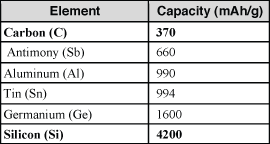Sep
22
Silicon Nanowires In Lithium Batteries Gets Closer
September 22, 2010 | 9 Comments
Back in January of 2008 we had a look at silicon nanowires with suspicions of the then 10-fold increase in capacity claims. Today Amprius is looking to get into the market with a doubling – still a huge improvement.
Amprius says it has developed batteries capable of storing twice as much energy as anything on the market today, thanks to nanostructured silicon electrodes. The company says it’s partnering with several as-yet unnamed major consumer electronics manufacturers to bring the batteries to market by early 2012. The batteries will allow portable electronics to run 40 percent longer without a recharge. The charge value keeps shrinking. Amprius also says it is working with several major automakers, unnamed as well, who are evaluating the electrode materials for use in batteries for electric vehicles.
Progress it seems is coming.
Silicon has better than 11 times the theoretical lithium storage capacity of the carbon materials used today to make battery anodes, but it’s been difficult for researchers to make silicon into a practical battery electrode. As large volumes of lithium ions move in and out of the material during charge and discharge, silicon swells and cracks.
As noted back 2008, Yi Cui, a Stanford University materials science and engineering professor, demonstrated that nanostructured silicon films could be charged and discharged of lithium without experiencing these mechanical problems, making a potential anode material that could as much as double the energy storage of lithium batteries.
In the 18 months since Amprius was founded, researchers at the company have built on Cui’s research and have demonstrated that the silicon anodes can be used in practical batteries. Silicon nanowires, which are vertically arrayed and tethered but flexible, are used to make the battery anodes.
Here’s Amprius’ new innovation – As the nanowires take in lithium, they can swell and bend to accommodate it, without breaking. However, this isn’t mechanically stable enough. Amprius has addressed this problem by giving the nanowires a thin, reinforcing metal core that the company likens to “rebar”, the steel strut used to reinforce concrete structures. This “rebar” prevents the anode from expanding and contracting too much. In testing, the silicon anodes can store three times more energy than carbon anodes by weight.
That must be the structural thing cutting back the original predictions.
Prototype batteries have been tested through 250 charging cycles and have been shown to store twice the energy of a conventional battery. Ryan Kottenstette, Amprius’ Director of Business Development says to be a serious contender for use in electric vehicles the batteries will need to go through 3,000 charging cycles.
Kang Sun, Amprius CEO says the company is moving aggressively to bring its batteries to electric vehicles. “We are in a hurry, because electrification is moving forward faster than anyone thought.” Sun is the former president of Chinese solar manufacturer JA Solar and notes that there are already about 80 electric-vehicle makers in China. “We have to be fast,” he says. The company expects to disclose some automaker partnerships in the next few months. That might point to where the unnamed manufacturers may be. Other manufacturers take note.
Kottenstette acknowledges that the vacuum deposition technique used for silicon nanowires will be more expensive. However, once potential manufacturing issues are ironed out, the company expects the boost in storage capacity to make up for the increased battery build cost. The company is also working on a roll-to-roll vapor-deposition system. “Making it compatible with current processes is important to us,” says Kottenstette. That would be useful as the conventional carbon anodes of today are made using large roll-to-roll systems.
One has to give Amprius credit – getting this far this fast is amazing. Building the silicon nanowires up over a core at a price that may be competitive to carbon using capacity as the factor is a substantial gain. If this works out, then mass production could pull the cost of capacity down even more as the demand for lithium would be spread out over much more product sales.
Amprius deserves congratulations. If the technology can improve to 3000 charge cycles or get further the battery would have immense appeal and longevity. As laptop owners know, replacement batteries are a significant cost issue. 3000 cycles for a vehicle might yield ten years – another doubling would reform the electric vehicle industry economics for consumers.
The improvements and new innovation in silicon and its use in nanowires is just getting started. Amprius is first, but that earlier prediction of the 10-fold increases is still out there.
A Hat Tip to Brian Wang at NextBigFuture.
Comments
9 Comments so far



Can’t wait for these to hit the market. And 19%+ efficient solar cells.
Superb blog post, I have book marked this internet site so ideally I’ll see much more on this subject in the foreseeable future!
Of course, what a great site and informative posts, I will add backlink – bookmark this site? Regards, Reader
I REALLY liked your post and blog! It took me a minute bit to find your site…but I bookmarked it. Would you mind if I posted a link back to your post?
Awesome post. I so good to see someone taking the time to share this information
Thanks for posting. Good to see that not everyone is using RSS feeds to build their blogs 😉
Intriguing post. I have been searching for some good resources for solar panels and discovered your blog. Planning to bookmark this one!
Nice post! You truly have a wonderful way of writing which I find captivating! I will definitely be bookmarking you and returning to your blog. In fact, your post reminded me about a strange thing that happened to me the other day. I’ll tell you about that later…
Good! Thank you! I always wanted to write in my site something like that. Can I take part of your post to my blog?